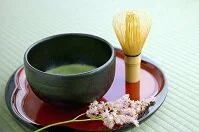Regional Variations, Specialties, & Unique Dishes
Sashimi: raw meat served alone, usually seafood and always served very fresh
Sushi: any food served with vinegar rice; the most common food served with the rice is seafood
Tempura: seafood or vegetables battered and deep fried
Teriyaki: meats cooked after being marinated in a soy sauce marinade
Dining Etiquette
Dining in Japan may occur on the floor so get your legs and back ready for a meal on the ground. While this isn't as common in many restaurants, you may encounter this setting there as well. In restaurants, you will most likely be greeted with a wet cloth, which should be used to wash your hands; do not touch your face or neck with this cloth. Once your cleansing has been finished, it's time to eat.
You may be served with individual plates or with shared plates, from which you take your own food. If you're served with communal plates, be sure to pick your food from those plates with the "opposite" ends of your chopsticks, in other words, the side you don't eat from. No matter the serving style, don't begin eating until you're either invited to or until you hear the word itadakimasu.
Depending on what's being served, it may or may not be accompanied by rice and/or soup, both of which are very common. If these are served, bring the bowl up to your mouth when eating these and if drinking soup, be sure to make a "slurping" noise to cool the soup. Generally, you shouldn't use your hands to eat anything and if eating sushi, be sure to dip it into any sauces with the rice side up, so the rice doesn't fall into the sauce.
If you' host invites you to consume alcohol, be sure to drink in moderation as drunkenness, particularly in a business setting is deemed highly inappropriate. You should also never fill your own glass; be sure to fill your neighbor's glass and your neighbor will surely fill yours as well. If you want no more to drink, be sure to leave your glass nearly full.
As you complete your meal, finish every last grain of rice and all the food on your plate. To symbolize that you are finished, place your chopsticks back on the chopstick rest. If at a restaurant, the inviter generally pays for all guests, but it is appreciated to offer to help pay.
If looking to grab a quick bite to eat from a street vendor or at a fast food restaurant, be aware that eating or drinking in public is considered very rude so take a couple minutes to dine where you purchase your food.
There is no tipping in Japan and offering a tip is actual an insult. This however doesn't make service poor; the Japanese provide incredible service.
Celebrations & Events
Japan has a large number of celebrations that are associated with foods. For example, during the Gion Festival, hamo (eel) and chimaki (sweet rice cakes) are commonly served. Other dishes, including osechi (boxed foods with various foods in each box), botamochi (rice dumplings), and sekihan (red rice) are common at nearly all celebrations.
Drinks

Tea
The Japanese's favorite non-alcoholic beverage is tea, although it seems every import in the world can be found in Japan.
The Japanese drink all sorts of alcohol from beers to wines and hard liquors, but the local drink, sake (rice wine, generally with a high alcohol content) is still one of the most popular. Another local drink is Shochu, which is typically distilled from barley, but can be produced from any number of starches.
Generally speaking, the tap water is safe to drink in Japan, but check with locals for any particular regional differences. Also, many people may have troubles adjusting to the local tap water, as it will most certainly be different from what your system is used to.